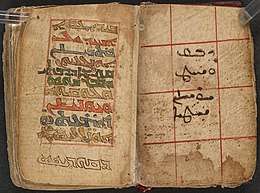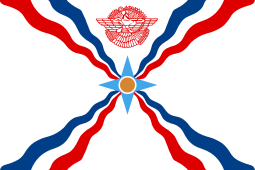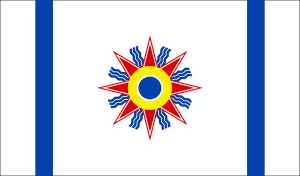Chaldean Neo-Aramaic
Chaldean Neo-Aramaic, or simply Chaldean, is a Northeastern Neo-Aramaic language[3] spoken throughout a large region stretching from the Nineveh plains, in northern Iraq, together with parts of southeastern Turkey.
| Chaldean Neo-Aramaic | |
|---|---|
| Sūreṯ | |
| ܣܘܪܝܬ | |
 Sūret written in Syriac (Madnḥaya script) | |
| Pronunciation | [ˈsu:rɪtʰ] |
| Native to | Iraq, Turkey |
| Region | Mosul, Ninawa; now also Baghdad and Basra |
Native speakers | 241,610 (2019)[1] |
Afro-Asiatic
| |
| Syriac | |
| Language codes | |
| ISO 639-3 | cld |
| Glottolog | chal1275[2] |
Chaldean Neo-Aramaic is closely related to Assyrian Neo-Aramaic, where it is considered a dialect of that language. Most Assyrians in Iraq, Iran and the Khabour River Valley in Syria speak either the Chaldean Neo-Aramaic or Assyrian Neo-Aramaic variety, two varieties of Suret. Despite the two terms seeming to indicate a separate religious or even ethnic identity, both dialects or languages and their native speakers originate from and are indigenous to the same Upper Mesopotamian region (what was Assyria between the 9th century BC and 7th century BC).[4][5][6]
History
Imperial Aramaic was adopted as the second language of the Neo-Assyrian Empire by Tiglath-Pileser III in the 8th century BC in account of the mostly Aramaic population in areas conquered west of the Euphrates. On the Western periphery of Assyria there had been widespread Aramean-Akkadian bilingualism at least since the mid-9th century BC. Aramaic would supplant Akkadian throughout the entire empire.[7]
Chaldean Neo-Aramaic is one of a number of modern Northeastern Aramaic languages spoken by Syriac Christians native to the northern region of Iraq from Kirkuk through the Nineveh plains, Irbil and Mosul to Dohuk, Urmia in northwestern Iran, northeastern Syria (particularly the Al Hasakah region) and in southeast Turkey, particularly Hakkari, Bohtan, Harran, Tur Abdin, Mardin and Diyarbakir. The Assyrian Christian dialects have been heavily influenced by Classical Syriac, the literary language of the Church of the East and the Chaldean Catholic Church in antiquity. Therefore, Christian Neo-Aramaic has a dual heritage: literary Syriac and colloquial Neo-Assyrian Eastern Aramaic. The closely related dialects are often collectively called Soureth, or Syriac in Iraqi Arabic.
Jews and Mandeans speak different dialects of Aramaic that are often mutually unintelligible.
Dialects
Chaldean Neo-Aramaic and Assyrian Neo-Aramaic originate in the Nineveh Plains and Upper Mesopotamia, a region which was an integral part of ancient Assyria between the 9th century BC and 7th century BC. Chaldean (Assyrian) Neo-Aramaic bears a resemblance to the Assyrian tribal dialects of Tyari and Barwar in the Hakkari Province, although the Assyrian dialects do not use the pharyngeals /ħ/ and /ʕ/.
Loanwords of Arabic, Persian and Kurdish origin exist in the language, as with Assyrian.
Phonology
Consonants
| Labial | Dental/ Alveolar |
Palatal | Velar | Uvular | Pharyngeal | Glottal | |||||||||||
|---|---|---|---|---|---|---|---|---|---|---|---|---|---|---|---|---|---|
| plain | emph. | ||||||||||||||||
| Nasal | m | n | |||||||||||||||
| Plosive | p | b | t | d | tˤ | k | ɡ | q | ʔ | ||||||||
| Affricate | tʃ | dʒ | |||||||||||||||
| Fricative | sibilant | s | z | sˤ | ʃ | ʒ | |||||||||||
| non-sibilant | f | v | θ | ð | ðˤ | x | ɣ | ħ | ʕ | h | |||||||
| Approximant | w | l | ɫ | j | |||||||||||||
| Rhotic | r | rˤ | |||||||||||||||
- The Chaldean dialects are generally characterised by the presence of the fricatives /θ/ (th) and /ð/ (dh) which correspond to /t/ and /d/, respectively, in other Assyrian dialects (excluding the Tyari dialect). However, the standard or educational form of Chaldean would realize the consonants /θ/ and /ð/ as /tˤ/.
- Most Chaldean Neo-Aramaic varieties would use the phoneme of /f/, which corresponds to /p/ in most of Assyrian Neo-Aramaic dialects (excluding the Tyari dialect).
- In some Chaldean dialects /r/ is realized as [ɹ]. In others, it is either a tap [ɾ] or a trill [r].
- Unlike in Assyrian Neo-Aramaic, the guttural sounds of [ʕ] and [ħ] are used predominantly in Chaldean varieties; this is a feature also seen in other Northeastern Neo-Aramaic languages.[8][9]
Script
Chaldean Neo-Aramaic is written in the Madenhaya version of the Syriac alphabet, which is also used for classical Syriac. The School of Alqosh produced religious poetry in the colloquial Neo-Aramaic rather than classical Syriac in the 17th century prior to the founding of the Chaldean Catholic Church and the naming of the dialect as Chaldean Neo-Aramaic, and the Dominican Press in Mosul has produced a number of books in the language. Romanization of Syriac may be used to transliterate the Syriac script into Latin.
See also
Notes
- "Chaldean Neo-Aramaic". Ethnologue.
- Hammarström, Harald; Forkel, Robert; Haspelmath, Martin, eds. (2017). "Chaldean Neo-Aramaic". Glottolog 3.0. Jena, Germany: Max Planck Institute for the Science of Human History.
- Maclean, Arthur John (1895). Grammar of the dialects of vernacular Syriac: as spoken by the Eastern Syrians of Kurdistan, northwest Persia, and the Plain of Mosul: with notices of the vernacular of the Jews of Azerbaijan and of Zakhu near Mosul. Cambridge University Press, London.
- Nordhoff, Sebastian; Hammarström, Harald; Forkel, Robert; Haspelmath, Martin, eds. (2013). "Northeastern Neo-Aramaic". Glottolog 2.2. Leipzig: Max Planck Institute for Evolutionary Anthropology.
- Blench, 2006. The Afro-Asiatic Languages: Classification and Reference List
- Khan 2008, pp. 6
-
- Beyer, Klaus (1986). The Aramaic language: its distribution and subdivisions. Göttingen: Vandenhoeck und Ruprecht. ISBN 3-525-53573-2.
- Sara (1974).
References
- Heinrichs, Wolfhart (ed.) (1990). Studies in Neo-Aramaic. Scholars Press: Atlanta, Georgia. ISBN 1-55540-430-8.
- Maclean, Arthur John (1895). Grammar of the dialects of vernacular Syriac: as spoken by the Eastern Syrians of Kurdistan, north-west Persia, and the Plain of Mosul: with notices of the vernacular of the Jews of Azerbaijan and of Zakhu near Mosul. Cambridge University Press, London.
- Sara, Salomon I. (1974). A description of modern Chaldean. (Janua Linguarum : Series Practica, 213.) The Hague: Mouton de Gruyter.
See also
- Dani Khalil - a Chaldean homicide detective in Low Winter Sun



